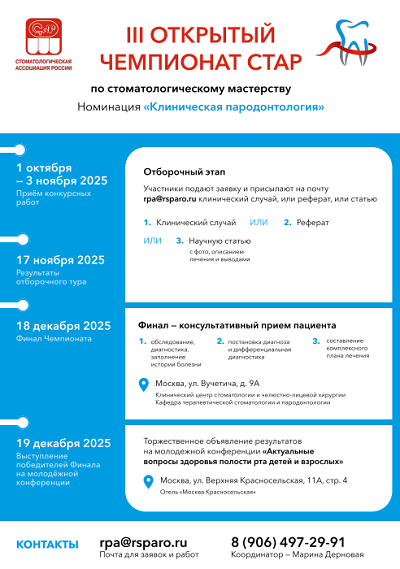Features of the work of a dentist and maxillofacial surgeon in a pandemic of a new coronavirus infection (COVID-19). World experience and own practice
https://doi.org/10.33925/1683-3759-2020-25-3-185-188
Abstract
Relevance. SARS-CoV-2 caused the pandemic of the new coronavirus infection (COVID-19) in the world. The virus belongs to the family of RNA-containing coronaviruses and is a representative of the Beta-CoV B line. Epidemiological analysis shows that the disease is transmitted by airborne droplets, airborne dust and contact routes. During dental treatment, patients are face-to-face with the doctor. Coughing, sneezing, salivation and blood may occur when using an ultrasonic or high-speed handpiece. If the patient is infected, then standard protective measures in everyday clinical work are not effective enough to prevent the spread of COVID-19, even if the patients are in an asymptomatic incubation period.
Purpose. A generalization of colleagues ’knowledge and their own practical experience is necessary for the proper organization of the provision of dental care to patients and minimization of the risk of infection in a pandemic of a new coronavirus infection.
Materials and methods. We analyzed the data of colleagues of dentists from different countries, and also presented our own understanding of the issues of dental care during a pandemic of a new coronavirus infection.
Results. In conclusion: the main important steps in the implementation of dental practice are during a pandemic: the doctor's compliance with the recommendations of the Ministry of Health of the Russian Federation on the prevention, diagnosis and treatment of new coronavirus infection (COVID-19); strict observance by the dentist and maxillofacial surgeon of the rules of their own safety; obtaining additional information from the history of possible risk factors for the patient; the correct use of the diagnostic algorithm depending on the pathology of the patient; the use of mainly disposable materials; flawless sterilization and disinfection of materials that are reused; competent aseptic processing of hands and mandatory work with gloves; prudent and proper use of personal protective equipment; disinfection measures; Class B medical waste disposal.
Conclusion. Knowledge of the clinical manifestations of the new coronavirus infection and methods for preventing infection of patients and medical personnel is necessary for each dentist and maxillofacial surgeon to prevent new episodes of spread and provide quality medical care.
About the Authors
N. I. MakovskayaRussian Federation
Makovskaya Nina I. - PhD, Assistant of the department of Oral and Maxillofacial Surgery A.A. Limberg North-Western SMU named after I.I. Mechnikov; All-Russian Center for ERM named after A.M. Nikiforovaof the Ministry of the Russian Federation for Civil Defense, Emergencies and Disaster Management.
SaintPetersburg
A. V. Vasilyev
Russian Federation
Vasilyev Aleksey V. - PhD, Md, DSc, Professor of the department of Oral and Maxillofacial Surgery A.A. Limberg North-Western SMU named after I.I. Mechnikov; Professor of the department of Oral and Maxillofacial Surgery Pavlov First Saint Petersburg SMU.
SaintPetersburg
References
1. J. Chen. Pathogenicity and transmissibility of 2019-nCoV-A quick overview and comparison with other emerging viruses. Microbes Infect. 2020;Mar;22(2):69-71. https://doi.org/10.1016/j.micinf.2020.01.004.
2. Ali Alharbi, Saad Alharbi, Shahad Alqaidi Guidelines for dental care provision during the COVID-19 pandemic. Saudi Dent J. 2020;Apr:7. https://doi.org/10.1016/j.sdentj.2020.04.001.
3. Prevention, diagnosis and treatment of new coronavirus infection (COVID-19). The sixth version of the temporary guidelines. https://static1.rosminzdrav.ru/system/attachments/attaches/000/050/116/original/28042020_МR_COVID-19_v6.pdf.
4. Temporary recommendations of the Dental Association of Russia “On the provision of emergency and emergency dental care in an epidemic of coronavirus infection”. http://www.estomatology.ru/star/work/2020/temp_recommend_covid_7apr.php.
5. X. Peng, X. Xu, Y. Li et al. Transmission routes of 2019-nCoV and controls in dental practice. Int J Oral Sci. 2020;12:9. https://doi.org/10.1038/s41368-020-0075-9.
6. Matthias Zimmermann, Emeka Nkenke. Approaches to the Management of Patients in Oral and Maxillofacial Surgery During COVID-19 Pandemic J Craniomaxillofac Surg. 2020;Apr;4;S1010-5182(20)30083-4. https://doi.org/10.1016/j.jcms.2020.03.011.
7. T. N. Trofimova, I.A.Garapach, N.S. Belchikova. Radiation diagnostics in dentistry. Moscow: Medical Information Agency Publishing House. 2010:192 p.
8. R. K. Bali, K. Chaudhry. Maxillofacial surgery and COVID-19, The Pandemic!! J Maxillofac Oral Surg. 2020;Apr;11:1-3. https://doi.org/10.1007/s12663-020-01361-8.
9. L. Meng, F. Hua, Z. Bian. Coronavirus Disease 2019 (COVID-19): Emerging and Future Challenges for Dental and Oral Medicine. J. Dent. Res. 2020;May;99(5):481-487. https://doi.org/10.1177/0022034520914246.
10. M. A. Cochran, C. H. Miller, M. A. Sheldrake. The efficacy of the rubber dam as a barrier to the spread of microorganisms during dental treatment. J. Am. Dent. Assoc. 1989;119:141-144. https://doi.org/10.14219/jada.archive.1989.0131.
11. M. Day. Covid-19: ibuprofen should not be used for managing symptoms, say doctors and scientists. BMJ. 2020;368:m1086. https://doi.org/10.1136/bmj.m1086.
12. S. Cantore, A. Ballini. Coronavirus Disease 2019 (COVID-19) Pandemic Burst and Its Relevant Consequences in Dental Practice. The Open Dentistry Journal. 2020;14:111-112. https://doi.org/10.2174/187421060201401011.
13. G. Spagnuolo, D. De Vito, Sandro. Rengo, M. Tatullo. COVID-19 Outbreak: An Overview on Dentistry Int. J. Environ. Res. Public Health. 2020;17(6):2094. https://doi.org/10.3390/ijerph17062094.
14. L. M. Tsepov, A. I. Nikolaev, M. M. Nesterova, E.L. Tsepova, A.L. Tsepov. Multiple chronic systemic diseases and periodontal pathology. Paradontologiya. 2019;24(2):127-131. https://doi.org/10.33925/1683-3759-2019-24-2-127-131.
15. N. Makovskaya, A. Vasilyev. HIV-infection in dentistry. Paradontologiya. 2016;21(4):24-27.
16. J. Jimenez-Cauhe, D. Ortega-Quijano, I. Carretero-Barrio, A. Suarez-Valle, D. Saceda-Corralo, C. Moreno-Garcia Del Real, D. Fernandez-Nieto. Erythema multiforme-like eruption in patients with COVID-19 infection: clinical and histological findings. Clin Exp Dermatol. 2020;May:9. https://doi.org/10.1111/ced.14281.
Review
For citations:
Makovskaya NI, Vasilyev AV. Features of the work of a dentist and maxillofacial surgeon in a pandemic of a new coronavirus infection (COVID-19). World experience and own practice. Parodontologiya. 2020;25(3):185-188. (In Russ.) https://doi.org/10.33925/1683-3759-2020-25-3-185-188




































